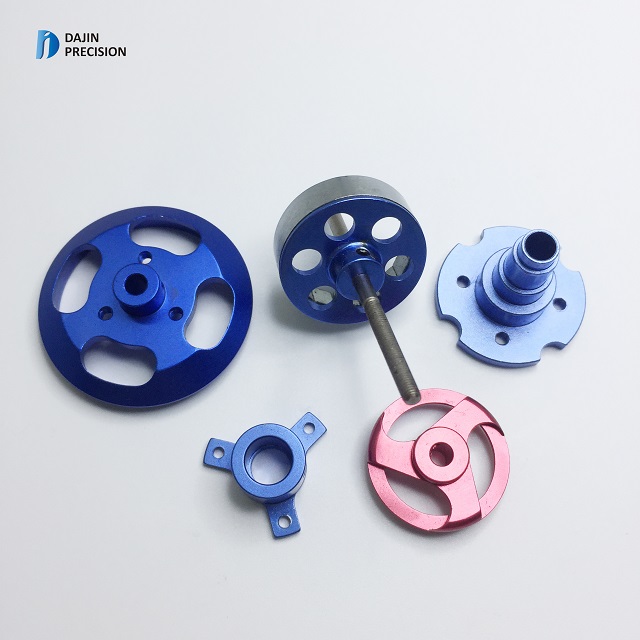Metal Finishing Types & How to Choose Right Surface Treatment Methods for Your CNC Machined Metal Parts
Metal finishing is used to change the appearance or improve the performance of machined metal parts through physical, chemical or mechanical processes. What metal surface finishing types you can use and how to choose the right one? Here dajinprecision.com introduces the common options of metal finishing and factors you should consider when finding the best surface treatment.

Metal Finishing Types - Common Metal Finishing Methods & Process
Different finishing methods may have different effects, but each option will apply a decorative or functional layer onto the surface, to achieve the required look or protective exterior.
1. Plating: the process of using a chemical solution to coat or deposit a thin layer of metal on the conductive surface, like zinc plating, nickel plating and chrome plating provided by Dajinprecision.com. It improves the corrosion resistance, surface friction, and durability of your CNC machined metal parts. Industrial plating can be divided into electroplating/electrodeposition and electroless plating.
2. Passivation: the process of removing surface contaminants from stainless steel or other metals, often applied as a part after zinc or zinc plating, it's used to prevent rust, enhance corrosion resistance, descaling, cleaning and more.
3. Anodizing/Anodized: the process of creating a thin protective anodized coating or film on aluminum machining parts or other metals through altering the molecular composition, which involves electrolytic passivation and can add a broad range of colors on your product, it's used to improve corrosion resistance, reduce wear and tear.
4. Sandblasting: also known as abrasive blasting, the process of propelling the abrasive material or blasting medium against the surface under high pressure to make the rough metal exterior become smooth, the smooth surface become rough or remove contaminants, which combines the cleaning, often treated before plating and painting, to make the preparation.
5.Painting: the process of applying a paint or pigment coating on metal parts to add color or protective layer on the surface through spraying or other methods.
6. Powder coating: similar to painting, adding a layer of melted plastic powder on the metal electrostatically and harden it to create a textured, matte, or glossy finish, it can be used to cover surface defects and improve impact resistance.
7. Hot blackening: similar to powder coating and plating, coats a thin layer of black oxide onto the metal machining products with a heated process, it's used to enhance abrasion resistance, and applicable for harder metals, like automotive components, firearms.
8. Grinding: an intense finishing technique for hard metals, put friction, attrition, and compression to produce a large selection of finishes with different levels of smoothness, it should take multiple steps to complete.
9. Polishing: the process to achieve a highly smooth and glossy surface with buff polishing machines, can round out the sharp edges, it's often used for decorative products that require exceptional luster.
10. Carburizing: a heat treatment process to diffuse the carbon to the metal workpiece to form a hardened surface.
11. Laser Engraving: a laser marking process, to engrave the CNC machined metal components with lasers for creating a lasting mark.
12. Shot Peening: similar to sandblasting, the process of propelling the shot onto the surface of metal parts, which results in a change of mechanical properties. It's used to reduce cracks and extend fatigue life.
How to Choose the Best Surface Treatment Methods
Each metal surface finishing process has its own function and disadvantages, you need to choose the right surface treatment methods based on your requirements, there are some factors and problems to help you make the decision.
1. What effect you want to achieve or what's the final use of your product?
Corrosion resistance, durability, hardness, colors, electrical conductivity, etc., what performance or elements your CNC machined metal parts required? Searching for the metal finishing methods can reach your goal.
2. How long the surface treatment will take?
Different surface treatments have varying processing cycle time, in order to control time and budget, make it is consistent with your production schedule and ensure all the steps can be accomplished on time.
3. How much the surface treatment will cost?
Cost is one of the most important considerations, you should think about whether the price is appropriate based on your budget, this will involve the CNC machining services supplier or metal finishing company you choose. From long-term cost, cost-effectiveness should be considered while not only the single prices.
4. What types of metals need to be treated?
Some metal finishing options are more suitable for specific materials like hard metals usually require higher strength polishing techniques or harder abrasives.
